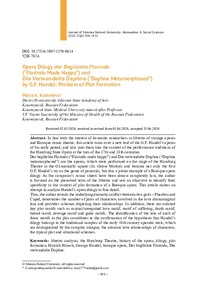Показать сокращенную информацию
Opera Dilogy der Beglückte Florindo (“Florindo Made Happy”) and Die Verwandelte Daphne (“Daphne Metamorphosed”) by G.F. Handel: Problem of Plot Formation
| Автор | Kosheleva, Maria A. | en |
| Автор | Кошелева, М.А. | ru_RU |
| Дата внесения | 2020-06-30T10:02:03Z | |
| Дата, когда ресурс стал доступен | 2020-06-30T10:02:03Z | |
| Дата публикации | 2020-06 | |
| URI (для ссылок/цитирований) | https://elib.sfu-kras.ru/handle/2311/135367 | |
| Аннотация | In line with the interest of domestic researchers in libretto of vintage operas and Baroque music theatre, this article turns over a new leaf of the G.F. Handel’s operas of his early period, and also puts them into the context of the performance traditions of the Hamburg State Opera at the turn of the 17th and 18th centuries. Der beglückte Florindo (“Florindo made happy”) and Die verwandelte Daphne (“Daphne metamorphosed”) are the operas, which were performed on the stage of the Hamburg Theatre at the Gänsemarkt square (lit. Geese Market) and became not only the first G.F. Handel’s try on the genre of pastorals, but also a prime example of a Baroque opera dilogy. As the composer’s music sheets have been almost completely lost, the author is focused on the preserved texts of the libretto and sets an objective to identify their specificity in the context of plot formation of a Baroque opera. This article makes an attempt to analyze Handel’s opera dilogy in fine detail. Thus, the author reveals the underlying dramatic conflict between two gods – Phoebus and Cupid, determines the number of pairs of characters involved in the love dramaturgical line and provides schemes depicting their relationships. In addition, there are enlisted key plot motifs such as mutual/unrequited love motif, motif of suffering, death motif, hatred motif, revenge motif and guile motifs. The identification of the role of each of these motifs in the plot contributes to the confirmation of the hypothesis that Handel’s dilogy belongs to the traditional samples of the early 18th century operatic texts, which are distinguished by the complex intrigue, the intricate love relationships of characters, the typical plot and situational schemes | en |
| Аннотация | В русле интереса отечественных исследователей к либретто старинных опер и музыкальному театру барокко данная статья открывает одну из новых страниц опер Г.Ф. Генделя, относящихся к раннему периоду творчества композитора, а также вписывает сочинения в контекст традиций постановок Гамбургского оперного театра рубежа XVII-XVIII столетий. «Счастливый Флориндо» и «Преображенная Дафна» – оперы, ставшие не только первым обращением Г.Ф. Генделя к жанру пасторали, но и ярким примером барочной оперной дилогии, постановки которых осуществлялись на сцене гамбургского театра на Gänsemarkt (площади Гусиного рынка). Так как музыка композитора практически полностью утеряна, в центре исследовательского интереса оказались сохранившиеся тексты либретто, определившие цель, заключающуюся в выявлении их специфики в контексте сюжетосложения барочной оперы. В статье предпринята попытка анализа оперной дилогии Генделя. Так, автором выявляется основной драматический конфликт между двумя богами – Фебом и Купидоном, определяется количество пар персонажей, участвующих в развитии любовной драматургической линии, и приводятся схемы, отображающие их взаимоотношения. Помимо этого, определяются такие ключевые сюжетные мотивы, как взаимная/безответная любовь, страдание, смерть, ненависть, месть, коварство. Выявление роли каждого из перечисленных мотивов в сюжетосложении способствует подтверждению того, что дилогия Генделя принадлежит к традиционным образцам оперных текстов начала XVIII века, отличающихся сложностью интриги, запутанностью любовных отношений персонажей, типичностью сюжетных и ситуационных схем | ru_RU |
| Язык | en | en |
| Издатель | Сибирский федеральный университет. Siberian Federal University | en |
| Тема | libretto analysis | en |
| Тема | the Hamburg Theatre | en |
| Тема | history of the opera | en |
| Тема | dilogy | en |
| Тема | plot formation | en |
| Тема | Hinrich Hinsch | en |
| Тема | George Handel | en |
| Тема | baroque opera | en |
| Тема | Der beglückte Florindo | en |
| Тема | Die verwandelte Daphne | en |
| Тема | анализ либретто | ru_RU |
| Тема | гамбургский театр | ru_RU |
| Тема | история оперы | ru_RU |
| Тема | дилогия | ru_RU |
| Тема | сюжетосложение | ru_RU |
| Тема | Хайнрих Хинш | ru_RU |
| Тема | Георг Гендель | ru_RU |
| Тема | опера барокко | ru_RU |
| Тема | «Счастливый Флориндо» | ru_RU |
| Тема | «Преображенная Дафна» | ru_RU |
| Название | Opera Dilogy der Beglückte Florindo (“Florindo Made Happy”) and Die Verwandelte Daphne (“Daphne Metamorphosed”) by G.F. Handel: Problem of Plot Formation | en |
| Альтернативное название | Оперная дилогия «Счастливый Флориндо» и «Преображенная Дафна» Г.Ф. Генделя: к вопросу о сюжетосложении | ru_RU |
| Тип | Journal Article | en |
| Контакты автора | Kosheleva, Maria A.: Dmitri Hvorostovsky Siberian State Academy of Arts Krasnoyarsk, Russian Federation; Krasnoyarsk State Medical University named after Professor V.F. Voyno-Yasenetsky of the Ministry of Health of the Russian Federation Krasnoyarsk, Russian Federation; mary777violet@gmail.com | en |
| Контакты автора | Кошелева, М.А.: Сибирский государственный институт искусств имени Дмитрия Хворостовского Российская Федерация, Красноярск; Красноярский государственный медицинский университет имени профессора В.Ф. Войно-Ясенецкого Минздрава РФ Российская Федерация, Красноярск | ru_RU |
| Страницы | 904–913 | ru_RU |
| DOI | 10.17516/1997-1370-0614 | |
| Журнал | Журнал Сибирского федерального университета. Гуманитарные науки. Journal of Siberian Federal University. Humanities & Social Sciences;2020 13 (6) | en |

